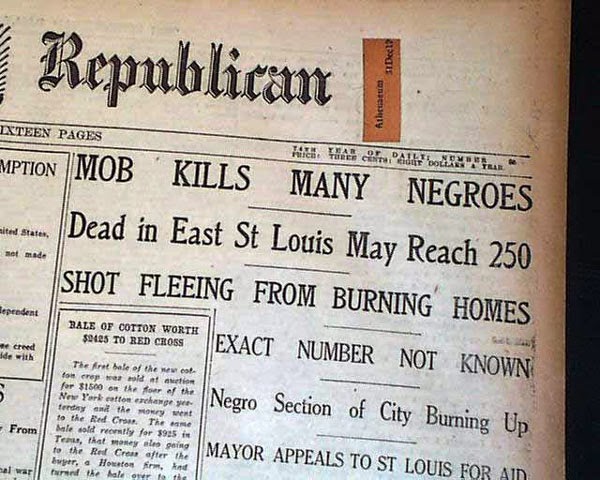The Influx of a New Labor Force Causes Friction
In the Spring of 1917, the United States had entered into World War I. Much of the available man power had gone into the armed forces to, as President Woodrow Wilson put it "make the world safe for democracy". This left a lot of jobs available and in part brought about the Great Migration out of the south towards the industrial centers of the north. Many of those migrating were black men with their families who were looking for a better life. Blacks were arriving in St. Louis at a rate of 2,000 per week. This caused friction with the mostly white labor unions which were seeking to protect their jobs against this encroachment by new workers. Marcus Garvey, a civil rights leader became aware of this, that Louisiana farmers were losing much of their labor force and sought the help of East St. Louis Mayor Mollman in discouraging this migration during the later weeks of May, 1917. Nevertheless, with many African Americans getting jobs at the Aluminum Ore Company and the American Steel Company in East St. Louis, many white workers feared for their job and wage security versus this new and culturally rural and thus very different labor force.
Tensions Boil Over During the Summer
It was in this charged and tense atmosphere that things boiled over. In May, three thousand white men assembled in downtown East St. Louis and as a mob began attacking blacks beating them and destroying
buildings. The Illinois governor called in the National Guard to stop the riots. There were rumors of organized retribution by black men, but the tensions eased for a few weeks. Then on July 2, a car occupied by white males drove through a black area of the city and fired several shots into a standing group. An hour later, a car with four white people in it including a journalist and a pair of police detectives was passing through the same section. Some of the black residents, apparently assuming that this was a car with the original shooters, opened fire on the car instantly killing one of the officers and fatally wounding another.
Later in that day, some thousands of white spectators who had assembled viewing the car as it had wound up, bloodied from the wounds of the policemen, went berserk and marched into black sections of town, conducting what amounted to an open season on
black citizens and all kinds of property. Rioters cut the water hoses of the Fire Department, and burnt entire sections of the town, in some cases, shooting inhabitants as they ran out of the buildings. Crying that "Southern negros deserved a genuine lynching!" the violent mob did indeed lynch several black men. National Guardsmen were called to the scene, but there are some accounts saying that some of these Guardsmen joined in the riots rather than stopping them. One account in the New York Times said that: "Ten or fifteen young girls about 18 years old, chased a negro woman at the Relay Depot at about 5 o'clock. The girls were brandishing clubs and calling upon the men to kill the woman."
The Aftermath: Further Anger and Radicalization
The riots went on for nearly a week, causing property damage estimated at close to $400,000. Over 6,000 black citizens, left East St. Louis altogether in fear for their lives. The city's death toll estimates varied quite a lot, with the city estimating about 100 black men had been killed, and the NAACP putting the total at 200. A congressional investigating committee would later conclude that 9 white and 39
black men had been killed. The number of black dead can only be guessed at as many of the black corpses were never recovered. But due to the property damage, over 6,000 black citizens were left homeless. The deadly viciousness of the attacks during these riots lead to the radicalization of many blacks throughout the country. Marcus Garvey voiced this sentiment saying that this riot was "one of the bloodiest outrages against mankind" and a "wholesale massacre of our people." Garvey went on to say that "This is no time for fine words, but a time to lift one's voice against the savagery of a people who claim to be the dispensers of democracy." The cartoon above summed up the feelings of many. The caption, echoing the rousing war-time slogan of President Wilson, had the woman saying: "Mr. President, why not make America safe for Democracy?"
What if anything does this account tell us about the events of today in Ferguson, Missouri? That is something that you - my readers - will have to draw what lessons you can yourselves. But here we have a number of similar elements... the actions of the Governor and the Mayor, the presence of outside influences (Al Sharpton, Jesse Jackson, & Marcus Garvey), and the use of National Guard troops. Those events - the rioting and looting of Summer, 1917 - were clearly a case of angry
white men attacking black citizens. The current events - the riots and looting of last night - are angry black citizens attacking a power structure which too many of them see as being biased against them. They may very well be right about that. But the rioting can only hurt their city and themselves. I have a friend, an older black woman who said to me: "This isn't the fault of the police.. you can have all the police out there, and all of those people marching for good reasons, but it only takes one man, or a few men to mess it all up for everyone... then one thing just leads to the other."
Sources:
http://en.wikipedia.org/wiki/East_St._Louis_riot
http://www.pbs.org/wgbh/amex/garvey/peopleevents/e_estlouis.html
"Race Rioters Fire East St. Louis and Shoot or Hang Many Negroes", New York Times, July 3, 1917.

















